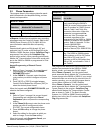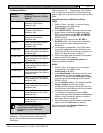
D9412GV3/D7412GV3 | Program Entry Guide | 2.0 Panel and Area Wide Parameters EN | 17
Bosch Security Systems, Inc. | 10/11 | F01U170807-02
Expand Test Report
Default: No
Selection:
Yes or No
Yes Off-normal events listed in Routing
Group Test Reports are reported to
the central station.
No Off-normal conditions for the events
listed in the Routing Group Test
Reports at test time are not reported.
Use this program item to add system event
information to scheduled Test Reports. Refer to
Section 4.2 Schedules (Skeds) on page 114.
This parameter relates to Sked Function
Code 9 (Test Report) because it allows a
Sked to send Expanded Test Report
information. Expand Test Report does
not affect Sked Function Codes 28
(Expanded Off-Normal Test Report) and
29 (Non-Expanded Off-Normal Test
Report).
2.3 Routing
Use routing to select full or partial groups of events to
report to up to eight different destinations (four over
phone, four over network).Routing includes choosing
the most important destination (route number),
reporting the events to a single or multiple destination,
and selecting a backup destination if the events fail.
Event routing can be sent over one of the following:
Standard telephone lines
Local-area network (LAN)
Wide-area network (WAN)
General Packet Radio System (GPRS)
Sending events over a LAN or WAN requires a
network interface module (NIM), such as the DX4020.
Sending events over GPRS requires a special NIM
(ITS-DX4020-G).
2.3.1 Called Party Disconnect
Telephone companies provide called party disconnect
to allow the called party to terminate a call. The called
party must go on hook (hang up) for a fixed interval
before a dial tone is available for a new call. This
interval varies with telephone company equipment.
D9412GV3/D7412GV3 firmware allows for called party
disconnect by adding a 35-sec on-hook interval to the
dial-tone detect function. If the control panel does not
detect a dial tone in 7 sec, it puts the phone line on
hook for 35 sec to activate called party disconnect.
The phone line goes off hook and begins a 7-sec dial
tone detect. If no dial tone is detected, the control
panel dials the number anyway. Each time the number
is dialed, the control panel records this as an attempt.
After ten attempts, the control panel enters
communications failure and Comm Fail Route #
appears on the keypads.
2.3.2 Route Number Groups: Which Has the
Highest Priority?
To program a group, first choose a route number. The
lower the route number, the higher priority that group
has (for example, events reported for Route 1 have a
higher priority than Routes 2, 3, or 4 if each group tries
to send a message at the same time). The priority of
the route numbers becomes important when
programming duplicate reports or choosing the events
you want to report first regardless of the number of
events that must report to multiple groups. Route 1
group primary device is the first destination the control
panel attempts to dial if an event in that group must be
reported. If the control panel is idle, any event
generated for any group starts a dialing sequence.


















